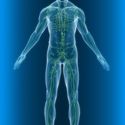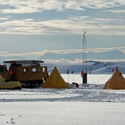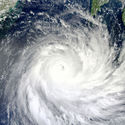The coldest, driest, windiest continent1 on Earth – Antarctica – seems an unlikely place to find plants. But they’re there – you just might not recognise them when you see them.
The Antarctic peninsula2 has a different climate3 from the continent itself – it’s warmer and it rains sometimes – and it’s here that you will find flowering plants: two species4 of grass.
The rest of Antarctica is covered by a huge mantle of ice, apart from exposed rocky areas near the Ross Sea that make up about 0.4 percent of the total land area. This is where you can find a surprisingly large number of plant species – mosses, algae5 and lichens. Their distribution is being studied as part of the Latitudinal Gradient Project. This is an international research project that is looking at changes in species numbers as you go further south, and which environmental factors affect plant distribution. Some of the scientists are investigating whether the plants have special adaptations6 allowing them to survive in Antarctica’s extreme conditions7 – as part of this, they sent lichens into space with a Russian unmanned flight in 2005! (The lichens survived.)
The number of species does vary. On the Antarctic mainland, there are 20–50 different lichens and from 2–15 species of moss. The number of species and the species themselves differ from site to site. There are far more plant species on the peninsula – 88–300 lichens and 20–90 mosses – with the larger number of species at the peninsula’s northern end.
How do these organisms survive the freezing Antarctic conditions? This has been the focus of ongoing research by Allan Green and his international collaborators. They’ve found that, during the winter, the plants dehydrate and enter a state of dormancy. When temperatures improve and when water is available, they rehydrate and are able to photosynthesise8 – something that may be possible for only a few days in the year
- continent: In geology, any of the main continuous expanses of continental crust on the Earth. Africa, Antarctica, Asia, Australia, Europe, North America and South America are recognised as continents, but this is based on historical and cultural attributes rather than geological attributes.
- peninsula: A large section of land that juts out into a body of water.
- climate: The weather conditions of an area averaged over a series of years, usually 30 or more.
- species: (Abbreviation sp. or spp.) A division used in the Linnean system of classification or taxonomy. A group of living organisms that can interbreed to produce viable offspring.
- algae: A large, diverse group of photosynthetic eukaryotic organisms. Algae have no stems or leaves and grow in water or on damp surfaces.
- adaptation: A change in the structure or function of something. In biology, a change in a species, as a result of natural selection. Individuals with a particular feature (adaptation) are more likely to survive and reproduce than individuals without this feature.
- condition: An existing state or situation; a mode or state of being.
- photosynthesis: A process that uses the energy from sunlight to convert carbon dioxide and water into carbohydrates, releasing oxygen as a byproduct. Photosynthesis occurs in the green parts of plants, in algae and in some microorganisms.









